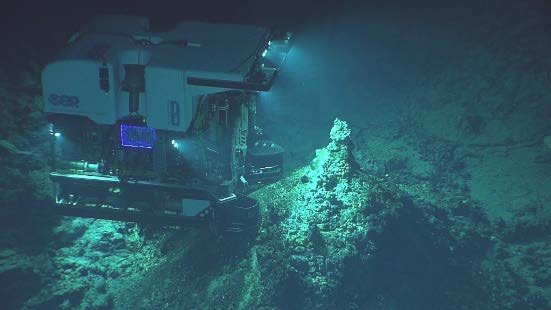Treasure or Trouble? The Deep Seabed Mining Dilemma

Source: NOAA Office of Ocean Exploration and Research, 2016 Deepwater Exploration of the Marianas
Commentary by Danel van Mensel, Intern, ICES
August 26, 2025
As the International Seabed Authority (ISA) concluded its 30th Assembly in Kingston from July
21-25, 2025, the outcome was clear: no exploitation licenses have been approved, and the
much-anticipated Mining Code remains incomplete.
Member states reaffirmed that commercial deep seabed mining cannot proceed without robust regulations
and sufficient scientific knowledge.
Deep seabed mining (DSM) refers to the
extraction of mineral resources - such as cobalt, nickel, manganese, and rare earth elements -
from the ocean floor, typically at depths of 4,000 to 6,000 meters. These minerals are
essential for clean energy and defence technologies, as well as for AI development. Most DSM
activity targets polymetallic nodules found in the Clarion-Clipperton Zone of the Pacific
Ocean, located beyond any country’s national jurisdiction. As such, DSM falls under the legal
authority of the ISA, which is mandated by the UN Convention on the Law of the Sea (UNCLOS) to
regulate exploration and exploitation in the international seabed area (“the Area”) for the benefit of all humanity.
Once a hypothetical opportunity and challenge
for future generations, DSM is now very much a live issue. Triggered by Nauru’s
invocation of the “two-year rule”
in 2021, the ISA has been under mounting pressure to finalize its Mining Code and respond to the
first potential commercial applications for exploitation. That deadline technically expired two
years ago - yet no exploitation license has been granted. With the absence of an agreed-upon Mining
Code, the recent session reiterated that mining cannot commence
without a complete regulatory framework.
At stake is not just a technical rulebook, but the very principle that the seabed
beyond national jurisdiction constitutes the “common heritage of mankind” - a cornerstone of the UNCLOS. In an era of growing demand for critical minerals essential
to the green transition, that principle is being tested like never before.
On one
end of the spectrum, China has embedded itself firmly within the ISA framework. As the largest
holder of exploration contracts and an active participant in rule-drafting, it champions a
rules-based yet strategically pragmatic approach. On the other, the United States - still
outside UNCLOS - has opted for an openly unilateral path. A
2025 Executive Order
by President Trump encourages U.S. companies to begin mining under alternative sponsorship arrangements,
primarily through small island states like Nauru and Tonga. This risks fragmenting the legal framework
underpinning deep seabed governance.
In between lies the European Union, which has
increasingly aligned itself with the global environmental community calling for a moratorium
or at least a precautionary pause. Eleven EU Member States, alongside the European Parliament,
now oppose DSM in the absence of robust scientific and legal safeguards. While Europe also
needs critical minerals, its strategy emphasizes circularity, recycling, and terrestrial
alternatives - an approach that positions the EU as a cautious guardian rather than an eager
extractor.
Norway, by contrast, continues to maintain a more
pragmatic position
on deep seabed mining. Unlike much of the EU, it has not called for a full moratorium and has argued
that Europe's reluctance could result in falling behind countries like China that are accelerating
their seabed resource programs. Norway supports accelerated negotiations under the ISA, but with
careful environmental safeguards rather than blanket delays.
The 30th Assembly
represents progress in strengthening the ISA’s institutional framework, but the Authority
remains at a decisive juncture. The path forward is clear: finalize a Mining Code grounded in
rigorous environmental safeguards, equitable benefit-sharing, and transparent governance, or
risk ceding authority to unilateral actors whose actions could erode multilateral ocean
governance.
For Europe and China, this moment presents both a challenge and an
opportunity. As major economic actors with significant stakes in critical minerals, they could
choose to jointly champion a science-first, rules-based framework that ensures DSM proceeds,
if at all, as a carefully regulated global endeavour. While such collaboration may appear
ambitious given their differing strategic priorities, even limited alignment could enhance the
ISA’s credibility and help safeguard the Area from becoming a new domain of unregulated
resource exploitation.
Please note that views expressed by the author do not reflect the policies or positions of ICES.